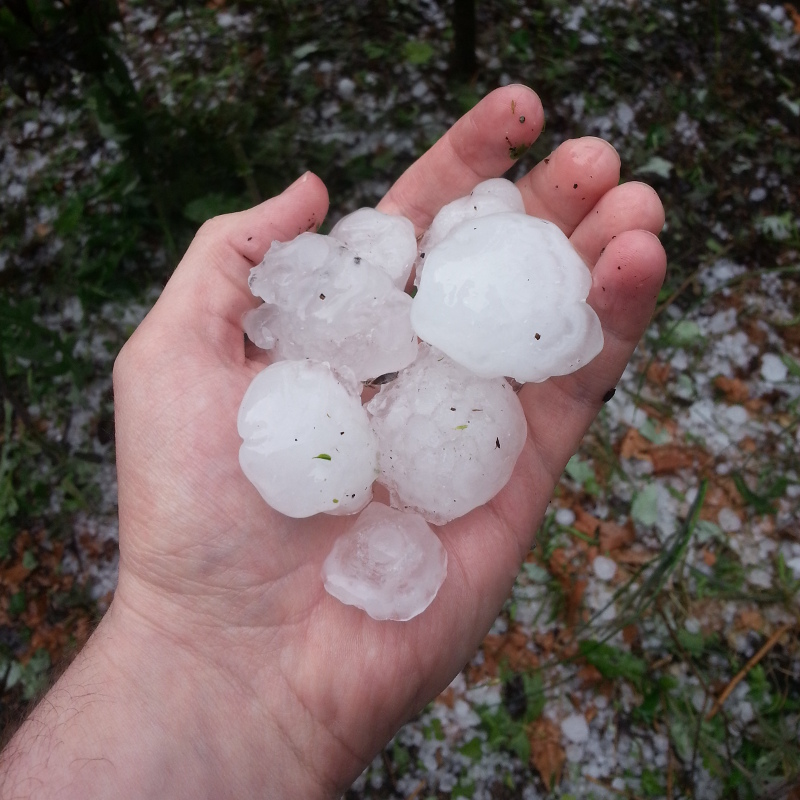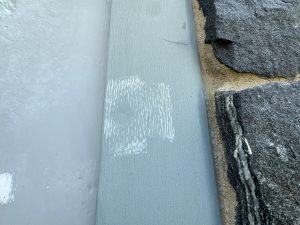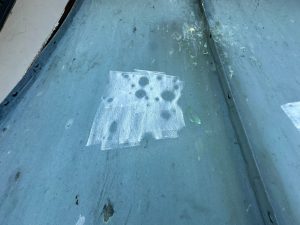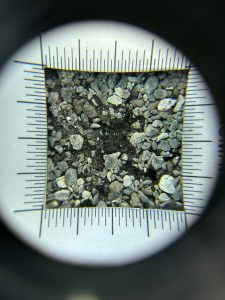Replacement. Repair. Beautification.

Crucial Measures to Take After Hail Damage Happens
Key Highlights
- Hail damage can cause significant damage to your property, including your roof, windows, and cars.
- It is important to assess the extent of the hail damage and take immediate action to ensure your safety and prevent further damage.
- Documenting the damage is crucial for filing an insurance claim and getting the necessary coverage for repairs.
- Selecting the right roofing contractor is essential to ensure quality repairs and a smooth repair process.
- Taking preventive measures, such as upgrading your roofing materials and regular maintenance, can help mitigate future hail damage.
Introduction
Hailstorms can be a destructive force of nature, causing significant damage to your property. From broken windows to dented cars, hail can wreak havoc on various surfaces. One area that is particularly vulnerable to hail damage is your roof. The impact of hailstones can cause shingles to crack, dislodge, or even puncture, leading to potential roof leaks and further property damage. In this blog, we will discuss the crucial measures you need to take after hail damage occurs to ensure the safety of your family and the protection of your property.
Immediate Steps to Take Following Hail Damage
After a hailstorm, it is important to prioritize safety first. Ensure that your family is safe and unharmed. Once everyone is accounted for, assess the extent of the hail damage from a safe distance. Look for signs of significant damage, such as broken or dislodged shingles, dents on metal surfaces, and cracks in windows. It is advisable to take immediate action to prevent further damage, such as covering broken windows with plastic or temporary repairs to prevent leaks.
Safety First: Ensuring Your Family’s Well-being
When hailstorms hit, it is crucial to prioritize the safety of your family. Seek shelter in a sturdy building and stay away from windows and exterior walls. Keep in mind that hailstones can vary in size, ranging from small pea-sized hail to larger golf ball-sized hail. The severity of the hail can depend on factors such as wind speed and direction. It is important to stay informed about severe weather conditions and follow any alerts or warnings issued by local authorities. Additionally, it is advisable to have an emergency plan in place, including a designated safe area within your home where your family can seek shelter during severe storms.
Assessing the Extent of Hail Damage from a Safe Distance
After the hailstorm has passed, it is important to assess the extent of the hail damage, but it should be done from a safe distance. Look for signs of significant damage, such as broken or dislodged shingles, dents on metal surfaces, and cracks in windows. Hail impacts can cause shingles to crack, dislodge, or even puncture, which can lead to potential roof leaks and further property damage. Additionally, check for granule loss on asphalt shingles. Granules act as a protective layer and help prolong the life of your roof. Significant granule loss can leave your roof vulnerable to further damage.
Documenting the Damage for Insurance Claims
Documenting the hail damage is crucial for filing an insurance claim and getting the necessary coverage for repairs. Take detailed photographs of the damage, both close-up and wide-angle shots, to provide a comprehensive view of the affected areas. Make sure to capture the extent of the damage to your roof, windows, and any other property affected by the hailstorm. Keep a detailed record of damages and repairs, including receipts, invoices, and any communication with insurance companies. This documentation will serve as proof of the damage and help expedite the insurance claims process.
How to Photograph Hail Damage Effectively, and safely
When documenting hail damage, ensure photographs are clear and comprehensive. Start by capturing the overall view of the property, focusing on the roof, siding, and gutters. Take close-up shots to reveal the hail impacts, granule loss, and any dents or bruises. Use proper lighting and angles to highlight the severity of damage, capturing both small and significant dents. Pay attention to detail, as these images are crucial for insurance claims. Prioritize safety by taking pictures from the ground or a stable ladder, avoiding risky positions.
Keeping a Detailed Record of Damages and Repairs for New Roof LLC
Keeping a detailed record of the hail damage and subsequent repairs is essential for both insurance claims and future reference. Create a folder or a digital file where you can store all relevant documents, including photographs, receipts, and invoices. This will help you keep track of the damage assessment, repairs made, and any temporary repairs done to prevent further damage. It is also advisable to document any communication with your insurance company, including claim numbers, adjuster visits, and correspondence. By maintaining a detailed record, you can ensure that the necessary repairs are properly documented and expedited.
Understanding Your Homeowner’s Insurance Policy
Understanding your homeowner’s insurance policy is crucial when it comes to filing a hail damage claim. Review your policy to understand the extent of coverage for hail damage and any deductibles that may apply. Most homeowner’s insurance policies cover hail damage, but it is important to know the specific terms and conditions. Comprehensive coverage typically covers hail damage as well as other forms of storm damage. Familiarize yourself with the claims process and any specific requirements for filing a hail damage claim.
Navigating Through Insurance Coverage for Hail Damage
Navigating through insurance coverage for hail damage can feel overwhelming, but understanding the process can help streamline the claims process. Contact your insurance company as soon as possible after the hailstorm to report the damage and initiate the claims process. They will guide you through the necessary steps and requirements for filing a claim. Provide them with the documentation, including photographs and detailed records of the damage and repairs. Depending on the severity of the hailstorm and the extent of the damage, an adjuster may be sent to assess the damage in person. Be prepared to provide additional information and documentation as requested by your insurance company.
The Importance of Timely Claims Submission
Submitting your hail damage claim in a timely manner is crucial for a smooth claims process. Insurance companies often have specific timeframes within which you must file a claim after the hail damage occurs. Delaying the claims submission may result in complications and potential denial of coverage. Act promptly and contact your insurance company as soon as you can to report the hail damage and initiate the claims process. Provide them with all the necessary documentation, including photographs and detailed records of the damage and repairs. By submitting your claim in a timely manner, you increase the chances of receiving the necessary coverage for your hail damage repairs.
Selecting the Right Roofing Contractor for Repairs
Selecting the right roofing contractor for hail damage repairs is crucial to ensure quality repairs and a smooth repair process. Consider the following factors when choosing a roofing contractor:
- Reputation: Look for contractors with a good reputation and positive reviews from previous customers.
- License & Insurance: Ensure that the contractor is licensed and insured to protect yourself from liability.
- Manufacturer Certifications: Check if the contractor has certifications from roofing material manufacturers, indicating their expertise and quality of work.
- Warranties: Inquire about any warranties or guarantees provided by the contractor for their workmanship and materials.
Taking the time to research and choose a reputable roofing contractor will help ensure that your hail damage repairs are done properly and with the highest quality standards.
Why Choose an Insurance Preferred Roofing Contractor?
Choosing an insurance preferred roofing contractor has several advantages when it comes to hail damage repairs. Insurance preferred contractors have established relationships with insurance companies and are familiar with the claims process. They understand the requirements and documentation needed for a successful claim and can streamline the process for you. Additionally, insurance preferred contractors often undergo rigorous training and meet specific standards set by insurance companies, ensuring that they provide quality repairs. By choosing an insurance preferred roofing contractor, you can have peace of mind knowing that your hail damage repairs will be handled by professionals who are well-versed in the insurance claims process and committed to providing quality workmanship.
Questions to Ask Potential Roofing Contractors
When evaluating potential roofing contractors for hail damage repairs, it is important to ask the right questions to ensure that you choose the best contractor for the job. Here are some questions to consider:
- How long have you been in business?
- Are you licensed and insured?
- Do you have experience with hail damage repairs?
- Can you provide references from previous customers?
- What warranties or guarantees do you offer for your workmanship and materials?
- How do you handle the insurance claims process?
- What is the timeline for completing the repairs?
- Do you offer a free inspection and estimate?
Asking these questions will help you assess the contractor’s qualifications, experience, and commitment to quality repairs, ensuring that you choose a contractor who can effectively handle your hail damage repairs.
The Repair Process: What to Expect
Understanding the repair process for hail damage can help you better navigate the repairs and know what to expect. After selecting a roofing contractor, they will assess the extent of the roof damage and provide you with an estimate for the repairs. The repairs may involve replacing damaged shingles, repairing flashing, or addressing any structural issues caused by the hail impacts. The contractor will work with you to schedule the repairs and ensure that the necessary materials and equipment are available. Throughout the repair process, communication with your contractor is key to ensure a smooth and successful repair experience.
Initial Inspection and Roof Damage Assessment
During the initial inspection, the roofing contractor will assess the extent of the roof damage caused by the hail impacts. They will carefully inspect the roof, looking for cracked or dislodged shingles, damaged flashing, and other signs of hail damage. The contractor may also assess the structural integrity of the roof to determine if any repairs or reinforcements are necessary. This initial inspection will provide the contractor with the information needed to develop a repair plan and provide you with an estimate for the repairs. It is important to collaborate closely with your contractor during this process to ensure that all the necessary repairs are identified and addressed.
Working with Your Contractor for a Smooth Repair Process
Collaborating closely with your contractor is crucial for a smooth and successful hail damage repair process. Work together to establish clear communication channels and expectations. Discuss the timeline for the repairs and any specific requirements or preferences you may have. Stay in regular contact with your contractor to address any questions or concerns that may arise during the repair process. By fostering a collaborative relationship with your contractor, you can ensure that the repairs are completed to your satisfaction and that any issues or challenges are addressed promptly. A smooth repair process will help restore your roof to its pre-hail damage condition and provide long-lasting protection for your property.
Preventive Measures for Future Hail Storms
Taking preventive measures can help mitigate potential damage from future hail storms. Consider the following measures to enhance your property’s hail resistance:
- Upgrading Roofing Materials: Install roofing materials that are specifically designed to withstand hail impacts, such as impact-resistant shingles or metal roofing.
- Regular Maintenance: Conduct regular inspections and maintenance to identify and address any potential vulnerabilities or areas for improvement.
- Mitigate Damage: Trim overhanging tree limbs that could potentially damage your roof during a hail storm.
- Reinforce Structures: Strengthen the structural integrity of your property to better withstand severe weather conditions.
By implementing these preventive measures, you can minimize the risk of hail damage and protect your property more effectively against future hail storms.
Upgrading Roofing Materials for Better Hail Resistance
Upgrading your roofing materials can significantly enhance your property’s hail resistance. Consider the following options:
- Impact-Resistant Shingles: These shingles are specifically designed to withstand hail impacts and are often rated for their resistance to specific hail sizes.
- Metal Roofing: Metal roofs are highly durable and can offer excellent protection against hail damage. They are less likely to crack or shatter from hail impacts.
- Synthetic Roofing Materials: Some synthetic materials, such as rubber or plastic, can provide increased hail resistance compared to traditional roofing materials.
Consult with a roofing professional to determine the best roofing material options for your property based on your specific needs and the severity of hail storms in your area.
Regular Maintenance Tips to Mitigate Future Damage
Regular maintenance is essential to mitigate future hail damage and ensure the longevity of your roof. Here are some maintenance tips to consider:
- Conduct regular roof inspections to identify any signs of damage or vulnerabilities.
- Clean gutters and downspouts regularly to ensure proper drainage and prevent debris buildup.
- Trim overhanging tree branches that could potentially damage your roof during a hailstorm.
- Consider installing hail-resistant skylights and windows.
- Stay informed about the size of hail typically experienced in your area and take necessary precautions.
By implementing these maintenance tips, you can reduce the risk of damage from future hailstorms and protect your property more effectively.
Conclusion
In conclusion, taking prompt action after hail damage is crucial to safeguard your property and ensure a smooth recovery process. From prioritizing safety to documenting damages for insurance claims and selecting the right roofing contractor, each step plays a vital role in restoring your home’s integrity. Understanding your homeowner’s insurance policy and submitting timely claims are key to receiving adequate coverage. Additionally, implementing preventive measures and regular maintenance can help enhance your property’s resilience against future hail storms. Remember, proactive measures today can prevent costly repairs tomorrow. If you need further assistance or guidance, feel free to get in touch with us for expert advice and support.
Frequently Asked Questions
How Long Do I Have to File an Insurance Claim After Hail Damage?
The timeframe to file an insurance claim after hail damage varies depending on your insurance company and policy. It is advisable to contact your insurance company as soon as possible after the hail damage occurs to initiate the claims process and ensure timely claims submission. Prompt action can help expedite the claims process and ensure that you receive the necessary coverage for your hail damage repairs.
Can Minor Hail Damage Lead to Bigger Problems if Left Unrepaired?
While minor hail damage may seem insignificant, leaving it unrepaired can lead to more serious problems in the future. Even small dents or cracks in shingles can compromise the integrity of your roof and eventually lead to leaks and further property damage. It is important to address minor hail damage promptly to prevent future problems and costly repairs.




